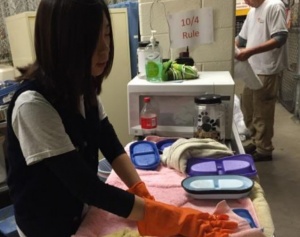

The wagging tails and animal snuggles make Wenjie Wang’s day when she volunteers at Friends of the Dearborn Animal Shelter.
However, the occasional sore back and neck do not.
“When you see the faces of the dogs and cats you know all the effort is worth it, but the work is repetitive and onerous,” said Wang, a University of Michigan-Dearborn graduate student.
So Wang was happy to learn about a project in Bochen Jia’s Human Factors and Ergonomics course to provide solutions for the nonprofit. Students, using methods learned in class, evaluated the shelter and came up with ideas to make the work environment less physically taxing.
The team of first-year graduate students—composed of members Wang, Pranav Indi, Edna Martinez, Joel Church and Jie Ren—did even more than come up with a plan. They sent their 75-page report “Ergonomic Risk Analysis of an Animal Shelter” to Auburn Engineers, who hosted the 9th Annual Ergonomics Design Competition for Student Teams competition and placed third.
This is the second year Jia’s students participated in the contest. Last year, a team from Jia’s class placed sixth.
“This is a very intense competition. The students compete with many others from universities around the nation,” said Jia, assistant professor of industrial and systems engineering. “Not only did they do very well in the competition, the animal shelter wants to apply their solutions. Students saw the importance of their work in many ways.”
Using ergonomic evaluation tools, Jia’s students looked at tasks such as dog walking, grooming, feeding the animals, cleaning laundry and washing dishes. Ergonomic solution suggestions included implementing the use of gentle leader leashes, increasing the height of the bathing workstation, adding feeding wall mount dispensers throughout the shelter, a new laundry process and streamlining the dish cleaning process.
Jia, who has taught the course for three years, said he continuously looks for ways to bring the real world into the classroom—such as incorporating competitions and company partnerships and using ergonomics computer software.
“It’s one thing to learn to solve the issues in class, but I want students to reach out and see the real-world problems, to help solve the problems, to apply what they learn,” Jia said.
Martinez said her time as a student in Jia’s course helped her grown personally and professionally.
“It opened my eyes that ergonomic and human factor issues are around us wherever we go. Now when I go to places, I start looking at things to see if they can cause injuries or not, and how would I solve those problems,” she said. “Dr. Jia has helped me see things differently. We were ecstatic with our results, but we are even more thankful for Dr. Jia being at UM-Dearborn and providing such an opportunity to the class.”




